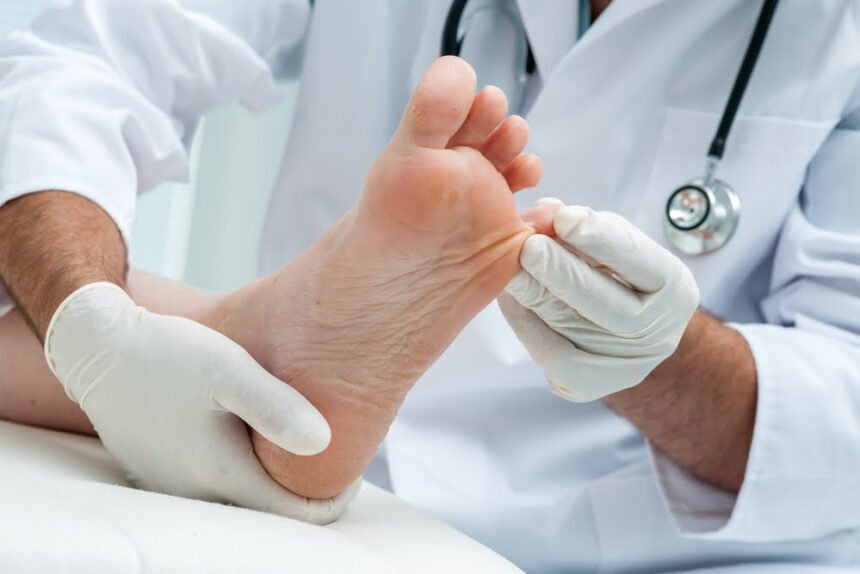We need our feet in working condition to get around and accomplish daily tasks. When walking causes pain, the effect on our lives is immediate. And with a myriad of feet ailments as our potential perpetrators, narrowing down a true cause can be difficult. Learning what the causes can be is equally as tricky. Fortunately, there’s a solution for every foot problem. Use this list of the top reasons why your feet hurt when walking to find the cause of your pain and treat it.
1. Plantar Fasciitis
Plantar fasciitis occurs when the plantar fascia tears and becomes inflamed. These microtears typically worsen over time, especially if rest and support are not prioritized. The fascia itself is a fibrous tissue running from the base of the heel to your toes. Those with plantar fascia typically feel the most potent pain in their heel as they walk around after waking up. The sharp heel pain usually lessens as you begin moving around more, but strenuous exercise can irritate it again. Long walks or frequent walks can cause a rise in pain as well.
Treatment
To treat plantar fasciitis, one of your best options is custom-made insoles. These specially-made shoe insoles help cushion your heel and gently hold your foot in a position that doesn’t further strain the fascia. With your whole foot better supported, strain leaves the fascia and allows any microtears to finally begin healing. Other treatment options include rest, icing, anti-inflammatory medications, and night splints. As you undergo these treatments, it is important to pay attention to specific signs that indicate your plantar fasciitis is healing. These signs may include a decrease in pain and inflammation in the affected area, improved mobility and flexibility in the foot, reduced sensitivity or tenderness upon touching the plantar fascia, and an overall improvement in your ability to engage in daily activities without discomfort. It is important to note that the healing process may vary from person to person, so it is advisable to consult with a healthcare professional for an accurate assessment of your progress.
2. Metatarsalgia
Metatarsalgia occurs when the ball of your foot (or feet) becomes painful and sore. This usually happens after prolonged activities involving jumping or running. Shoes that are too tight can also lead to this painful condition. The pain typically worsens as you walk or perform other physical activities. You may also experience another strange symptom: feeling like there is a pebble stuck in your shoe. Tingling or numbness in the toes is also common. Walking barefoot on hard surfaces is often the most painful for those with metatarsalgia.
Treatment
You’ll want to give your foot some extra shock support to prevent the condition from coming back. Thick-soled shoes will do the trick, as do insoles. Rest and ice help reduce painful symptoms.
3. Bunions
Bunions, or hallux valgus, put painful pressure on the sides of your feet. This pain typically worsens as you walk around or exercise with shoes on. The bunion bump will likely turn red and feel inflamed after being irritated. Bunions form after a misalignment in the big toe goes on for too long. The big toe will wrongly point inward, at your other toes. The bony protrusion that is a bunion grows from the base of your big toe as a result. Wearing shoes may feel cramped and tight in addition to feeling pain.
Treatment
To reduce pain and irritation, opt for shoes with a wider toe box. There are also inserts available to correct the misaligned big toe, helping to reduce the cause of your symptoms. For pain management, make sure your shoes are spacious and that you’re taking over-the-counter pain medications as necessary. If the bunion is persistent, it can be surgically shaved down.
4. Calluses
Thick calluses can cause pain and general discomfort as you walk. These thickened patches of skin can disrupt the natural balance and alignment of your feet’s base, putting pressure on certain areas. The calluses themselves may feel tender and painful too, much like a bunion.
Treatment
Treating calluses is a fairly simple feat. Since they are a buildup of hardened skin, you need only remove the offending buildup. A soak in warm water will soften the skin, allowing you to remove it with a foot grater or pumice stone. Be gentle, as it may hurt if you use too much pressure.
5. Heel Pad Atrophy
The pad of fat encasing and supporting your heel can begin to shrink, or atrophy. Once the pad responsible for protecting your heel from brunt force shrinks away, you’ll begin to experience pain as you walk. A callus may form on your heel as your body tries to compensate for the loss in support and cushioning. The pain of heel pad atrophy generally feels like sore pressure, though a burning sensation can also point to this condition.
Treatment
Ice and rest help alleviate the pain caused by heel pad atrophy. For more long-term treatment, opt for orthotic insoles, as they help provide the cushioning and support your heel is lacking.
6. Turf Toe
Turf toe happens when the big toe hyperextends and sprains. The extension goes upward, with the toe pointing up towards the top of the foot. The name comes from the people who commonly experience this condition: athletes performing on artificial turf. With this condition, you’ll experience symptoms like swelling, inflammation, and pain that worsens over time. Repetitive motions increase the pain or a sharp and sudden injury. You may not notice symptoms when the condition starts, as turf toe isn’t always painful right out the gate.
Treatment
You can treat turf toe with a mixture of rest, ice, compression, and elevation (RICE). Most cases are treatable at home. Moderate to severe cases may need the help of a physiotherapist.
7. Tendinitis
When the fibrous tissues connecting muscle to bone become inflamed, tendinitis is born. This condition can happen throughout the body, but when present in the feet, walking and other motion activities become painful. Your specific symptoms will depend on which tendon is affected. For example, the Achilles, at your heel, or the extensor and peroneal tendons. The latter affects areas of your top and middle feet.
Treatment
Treating tendinitis is usually feasible through rest, ice, and over-the-counter pain medications. If symptoms and pain persist. you’ll benefit from the help of a physiotherapist. In severe cases, surgery may be needed.
8. Arthritis
There are two common types of arthritis that can plague feet. Osteoarthritis deteriorates the protective cushioning around the bones of your feet, specifically your heel. Stiffness and pain across your feet are common symptoms. Rheumatoid arthritis destroys ligaments and tendons within your body, which wreaks havoc on your feet. Swelling, pain, and redness are common symptoms of rheumatoid arthritis.
Treatment
Arthritis treatment varies based on how intense it is. Depending on your symptoms and the severity of your arthritis, rest and ice may do the trick, while others may need help from a physiotherapist, custom orthotic inserts, or at worst, surgery.
9. Flat Feet
Flat feet typically begin at birth, worsening as we age. Without proper remedies, flat feet can cause pain throughout the body. If your feet hurt when walking, check the bottoms of your feet. If they are almost completely flat against the ground, your arches are likely poorly supported, which can lead to a variety of painful symptoms. The bottom of your feet may feel sore and tender, or other areas of your feet may hurt as your body naturally attempts to compensate for a loss in arch support.
Treatment
Custom orthotic insoles are a proven successful treatment option for flat feet. They offer the support your arches so badly need, relieving the pain and symptoms associated with poor arch support. Rest and ice help reduce irritation and offer temporary pain relief, which can be excellent for managing symptoms.










